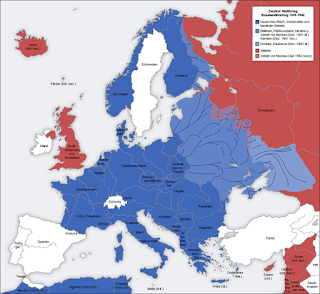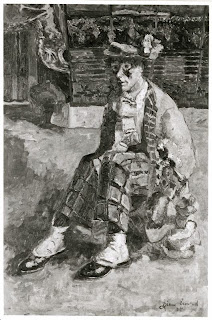by Marc Masurovsky

We just commemorated the 70th anniversary of the end of the Second World War, at least that portion of the war being fought on the European continent. It took another three months of heavy fighting, two atomic bombs, and an invasion of Japan to bring the Empire of the Rising Sun to the table and sign an unconditional surrender in mid-August of the same year.
Let’s try and imagine what it must have been like to wake up the day after the surrender of the Reich and to think about all that had occurred since Hitler took power in January 1933.
With 60 million people dead, including six million Jews, men, women and children, five million others who perished in prisons and camps, a third of the male population of the Soviet Union destroyed, one third of Europe’s infrastructure in ruins. Basically a traumatized world. Not a pleasant morning on which to view a sunrise.
Let’s focus on the thefts and displacements of objects. With every act of physical aggression comes a theft especially during military conflicts, civil disorder, and wholesale extermination of one group by another. In this case, the backdrop of a war on culture decreed by National Socialism everywhere Nazis set foot provoked a systematic and systemic displacement of objects from homes, businesses, and public places.
Take a camera with a very wide angle lens and click. The snapshot you record should tell you where objects were located on May 10, 1945.
In short, it was an utter mess. Displacement meant movement. Objects were removed from their original home and taken somewhere else, never to return again. Liberators, whether military or militia or resistance units, found “things” everywhere they went—barns, attics, basements, gyms, cellars, abandoned apartments and villas and farmhouses, barracks, everywhere someone with a gun showed up, there were objects strewn about or carefully stacked, no matter.
 There was no system in place on May 10, 1945 to properly dispose of “found” objects. It was all improvised which led to massive abuses, naturally, like theft.
There was no system in place on May 10, 1945 to properly dispose of “found” objects. It was all improvised which led to massive abuses, naturally, like theft.
In most places, objects did not travel very far. They remained within the immediate geographic area and ended up mostly in other people’s homes, which means that those objects were never recovered unless someone denounced you after the war ended, neighbors stealing from their neighbors, communities cannibalizing themselves.
Those objects which traveled far were those taken either by people fleeing one area and getting as far away as possible from the scene of the crime, or by paramilitary or military units, resistance groups on the prowl. In that case, objects could travel long distances, ten, one hundred, even one thousand kilometers or more.
So, on May 10, 1945, you must imagine that most objects that were removed illegally from people’s homes by neighbors, strangers, policemen, thugs, agents, soldiers, officers, either stayed on your street, or moved to another neighborhood, or another city, or another country, ultimately another continent.
On May 10, 1945, Europe was a mess, like an attic through which a tornado had passed and objects blown out and falling wherever.
That is why “things” taken from Western Europe went as far as Kiev, Ukraine.
 |
| Soviet counteroffensive, 1943-44 |
That is why “things” taken out of the Soviet Union went as far as Germany and Austria.
That is why “things” taken out of Norway went “south.”
 |
| Norway |
“Things” taken out of France went north, east, south, and west.
 |
| Northern France |
 |
| Axis-occupied Europe |
The problem of restitution on May 10, 1945, was a staggering mess with a crime scene engulfing 15 European countries.
Now, let’s finally get to the point.
How many objects were removed?
No number can adequately reflect the reality of the thefts.
But, governments and armies are in the business of releasing information which is supposed to be accepted as “official”, therefore not up for discussion.
When the French government says that 40,000 objects were removed from its territory, it’s because it recovered 40,000 objects from Germany, Austria and other places. Half of those objects presumably went through the Jeu de Paume in downtown Paris. That makes it easier to count.
On December 1, 1998, American pundits announced that there were 125,000 works of art still missing which needed to be identified, recovered and returned to their rightful owners. No one bothered to ask: How did you come up with that figure?
Then, as recently as this year, another figure was proposed: 600,000 objects were still missing. And yet again, no one bothered to ask where that figure came from and what documents were used to tabulate a figure which had grown more than five-fold in less than two decades.
At the end of the movie, “Woman in Gold” a text appears indicating that there are 100,000 works of art still missing. Already people who have seen the film are quoting that figure as if it is manna from heaven. But here again, where did the filmmakers obtain that figure? Does it apply only to Austria or to Europe as a whole? That figure mysteriously coincides with one put forth by the London-based Art Loss Register (ALR) as the total number of all objects in its registry of stolen objects, including contemporary commercial thefts.
The short answer is: no one knows because no one has bothered to know. Simple. If you don’t bother to know how many objects were stolen, you don’t really have to focus on restitution issues. The missing objects are gone with the wind, just like in the wake of a storm. Poof! Disappeared. It would be simpler to consider WWII and the Holocaust as a natural disaster. It does not work that way. These were nightmares created by human beings against other human beings, a man-made disaster which implies accountability.
If you do come up with a number like 100,000 or 125,000, you might have something in mind. Could it be that those 100,000 works of art are worth something? Could it be that the numbers game is all about value? And not necessarily about individual losses? That the only way to interest someone in restitution is to place a monetary value on an object?
Maybe, for some people, the “restitution game” is just a global treasure hunt where we forget about the “why”, the ”where” and the “how” of the thefts committed in the context of genocide. People hunt for treasures from the Holocaust the same way they look for metal on beaches and dive for gold laying about on the ocean floor. With a little effort, you too can get rich. Or so you think.
Except that we have no idea how to define a “treasure” and, for the most part, we don’t really know what we are looking for, except for objects listed on online databases.
The only way to understand the reality of the thefts that took place across Europe is to collect all relevant information about what disappeared, sift through the evidence, sort it, and catalogue it. This exercise began but was never finished in the years that followed May 9, 1945, perhaps because it took too much time and the chances of finding anything were deemed to be close to zero. So why bother? Instead of recording everything that was lost, the focus was placed on registering losses of “culturally significant” items. No one really defined “culturally significant” except to suggest that the loss of the cultural item meant a loss for the nation. In other words, someone had to decide whether your objects had any “cultural” meaning as determined by the government of your country. That “someone” was usually an art historian, a museum curator or director, or an official in a government ministry. This is where the recording of cultural losses crossed over into cultural policy and esthetics.
If you were unfortunate to have owned objects deemed “insignificant”, chances are that your government was not going to assist you in locating them.
 |
| insignificant? |
If, on the other hand, there was something “significant” about your collection, the government did take an interest and registered your claim.
 |
| significant? |
 |
| Treasure? |
 |
|
| unworthy? |
It is difficult to pinpoint the difference between significant and insignificant. If we use French archival records as a point of reference, those containing information about cultural losses as an example, we can begin to understand the difference.
The members of the Art Restitution Commission, Commission de récupération artistique (CRA), were mostly museum curators and art historians. They devised, perhaps through trial and error, a ranking system using different colored pencils and a lettering system from A to H. Each letter stood for a type of object. Many lists of losses submitted by victims were hardly annotated, meaning that there was little chance that the objects that they contained would ever be registered as “worthy” or “significant.” [This question will be explored in greater detail in future articles on plundered art. Stay tuned…]
As an example, the “Répertoire des biens spoliés”, a central registry that the French government published in 1947, can be viewed as a central catalogue of “culturally significant” objects listed as still missing by that date. Similar lists were published in other countries using different formulas and presentation schemes. But the end result was the same: these official lists tended to summarize, encapsulate the universe of what was missing as “significant” and what was being sought by the governments of the nations which had suffered under the Nazi boot.
It’s time to understand, better late than never, that art restitution, the idea of cultural loss, was quickly subverted even before the ink had dried on the act of surrender of the Third Reich. It was not about what you lost but whether what you lost was important enough for the government to take heed of your loss. The principle of restitution was transformed into an arbitrary State-sponsored diktat which implicitly carried a judgment about the quality of your losses and how the government perceived your ownership of cultural assets.
A far cry from being the victim of an act of cultural plunder and genocide.
That explains in part why restitution efforts fell far short of their potential, because they quickly had very little to do with you as an individual victim. The idea of ‘recovery’ was intertwined with the interest of the nation, of the State. When the State decided: enough was enough, it meant that it was no longer interested in promoting location, identification and recovery of objects, even those that were deemed “significant.” It was easier to mourn them as a nation’s loss than to make the effort to “find” them.
The irony of this exercise is that many “mourned” objects ended up sitting in the museums of the nations that “stopped looking for them.” Hypocrisy? Double speak? Or sheer deceit?
So, we are back to where we started: a staggering mess. The only way to solve it is through citizens’ initiatives, publicizing the losses, identifying where lost objects are located especially if they sit in State collections and demanding their return.
It is up to each and everyone of us to document these crimes and to tell their stories, not necessarily for the sake of restitution but to teach a public lesson about the crime of cultural plunder, to restore the word “significant” to its proper context and to assert that an individual’s cultural tastes and losses are not subject to government whims and elitist conceptions of “Kultur.”